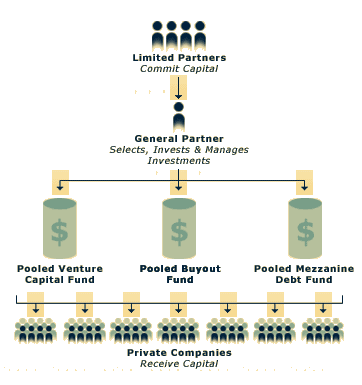 What Is Private Equity?
What Is Private Equity?
Private equity is the ownership of shares or other equity
or equity-like interests in companies that do not trade
publicly on a stock exchange, or over-the-counter, among
investment dealers. As there is no instantaneous market
for trading, these investments are appropriate only for
patient investors with a long-term view.
Because the investments often involve the acquisition of
a controlling interest or significant influence costing
several millions of dollars, private equity opportunities
are generally more appropriate for large institutional investors
with the time and resources to evaluate the potential risks
and returns, and the patience to wait 10 years or longer
to maximize investment returns.
* Venture Economics US Private Equity Performance Index
in USD as of June 30, 2004
The performance table shows that over the short term public
and private equities can have wide swings in performance.
Over the longer term private equity can generate superior
performance compared with public equity. The TSX Composite
Index is the broadest measure of public equities in Canada.
The S&P 500, NASDAQ, Russell 2000 and 3000 indexes in the
U.S. are reasonable public market proxies for companies
in the private market. The private market proxies for private
equity buyout and venture capital funds are developed by
Venture Economics, a U.S.-based provider of performance
data on the private equity industry.
Types of investments
There are basically three types of private equity investments:
- Venture capital, principally in early-stage companies
that are still developing their products or services,
yet have the prospect of generating revenue in a few years;
and later-stage firms generating revenue with the expectation
of profits within a year or two.
- Buyout and acquisition financing, usually accompanied
by a new business plan, and occasionally with new management,
to improve a company's financial performance.
- Expansion or merchant banking capital to established
companies looking to enter new markets or achieve a larger
scale of operations.
The private equity market
A manager, or general
partner, is the intermediary between investors with
capital and businesses seeking capital to grow.

General partners tend to specialize in companies:
-
within an industry or economic
sector, such as manufacturing, business services, life
sciences, telecommunications, technology or natural
resources;
-
at different stages of development,
such as start-ups or early-stage businesses, as well
as established companies looking for expansion capital,
or mature companies interested in a change of ownership
through management buyouts and acquisitions;
-
according to their size in terms
of capitalization, and
-
by geographic region, such as
Canada, the United States, Europe or Asia.
Performance-based compensation
Compensation to the general partner
is paid in the form of a profit participation, referred
to as carried interest, usually
ranging from 20 to 25% of profits realized when the underlying
companies are sold. The general partner usually draws an
annual advance of between 1.5 and 2.0% of committed capital
as management fees used to select and provide ongoing management
support to the underlying companies.
The carried interest is paid to the
general partner after a minimum rate of return to the limited
partners is achieved.
Earning acceptable returns takes
time
Investing in private equity funds
can produce low or negative returns in the early years.
The rewards usually come several years later as the
investments mature. This timing is known as the J curve
effect.
In the initial years, investment returns to the limited
partners are negative because the general partner's management
fees are drawn from invested capital, accounting and valuation
policies tend to result in portfolio writedowns occurring
more quickly than increases in carrying value, and because
lower performing investments are identified early relative
to the better peforming investments which are often held
longer and sold later in the life of a fund. Over time,
the progress made by investee companies justifies a value
for the business that is higher than its original cost,
resulting in unrealized gains. During the remaining period,
the higher value of the businesses is confirmed by the
partial or complete sale of companies, resulting in cash
flows and realized capital gains to the partners. Private
equity investing may involve a series of J curves because
capital is invested in different investment funds and
private companies at different times.
Valuation and performance measurement
In the early years of a private
equity fund, valuations of portfolio companies are utilized
to measure the performance of the portfolio. Private market
investments are carried at cost for at least the first
year of ownership. The sale of portfolio companies, or
public offerings of their shares, results in cash and
occasionally share distributions to the limited partners.
The most widely used measure of
performance is the internal rate
of return (IRR). The calculation of the IRR takes
into consideration the timing of cash distributions to
the partners (realized IRR), or the length of time an
investment has been held (unrealized IRR), relative to
when capital was drawn down to make each investment.
Another widely accepted measure of performance is
multiple of capital contributed
(MOC) or a multiple of distributions received relative
to the capital invested. This measures the proceeds
received when an investment is sold, or the valuation
of an investment still held, as a multiple of the
original cost of the investment. ROC does not take
into account the length of time between the date the
investment was made and the valuation date (unrealized
MOC), or the date the company was sold (realized MOC).
Source: CPP Investment Board
